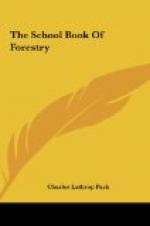Usually in the hardwood forests, there is not much cover, such as dry leaves, on the ground. Fires in these forests destroy the seedlings and saplings, but do not usually kill the mature trees. However, they damage the base of the trees and make it easy for fungi and insects to enter. They also burn the top soil and reduce the water-absorbing powers of the forest floor. In thick, dense evergreen forests where the carpet is heavy, fires are much more serious. They frequently kill the standing trees, burning trunks and branches and even following the roots deep into the ground. Dead standing trees and logs aid fires of this kind. The wind sweeps pieces of burning bark or rotten wood great distances to kindle new fires. When they fall, dead trees scatter sparks and embers over a wide belt. Fires also run along the tops of the coniferous trees high above the ground. These are called “crown-fires” and are very difficult to control.
The wind plays a big part in the intensity of a forest fire. If the fire can be turned so that it will run into the wind, it can be put out more easily. Fires that have the wind back of them and plenty of dry fuel ahead, speed on their way of destruction at a velocity of 5 to 10 miles an hour, or more. They usually destroy everything in their course that will burn, and waste great amounts of valuable timber. Wild animals, in panic, run together before the flames. Settlers and farmers with their families flee. Many are overtaken in the mad flight and perish. The fierce fires of this type can be stopped only by heavy rain, a change of wind, or by barriers which provide no fuel and thus choke out the flames.
Large fires are sometimes controlled by back-firing. A back-fire is a second fire built and so directed as to run against the wind and toward the main fire. When the two fires meet, both will go out on account of lack of fuel. When properly used by experienced persons, back-fires are very effectual. In inexperienced hands they are dangerous, as the wind may change suddenly or they may be lighted too soon. In such cases they often become as great a menace as the main fire. Another practical system of fighting fires is to make fire lines around the burning area. These fire lines or lanes as they are sometimes called, are stretches of land from which all trees and shrubs have been removed. In the centre of the lines a narrow trench is dug to mineral soil or the lines are plowed or burned over so that they are bare of fuel. Such lines also are of value around woods and grain fields to keep the fire out. They are commonly used along railroad tracks where locomotive sparks are a constant source of fire dangers.
Our forests, on account of their great size and the relatively small man force which guards them, are more exposed to fire dangers than any other woodlands in the world. The scant rainfall of many of the western states where great unbroken areas of forest are located increases the fire damages. The fact that the western country in many sections is sparsely settled favors destruction by forest fires. The prevalence of lightning in the mountains during the summer adds farther to the danger. One of the most important tasks of the rangers in the Federal forests is to prevent forest fires.




